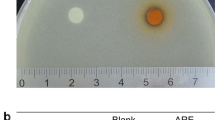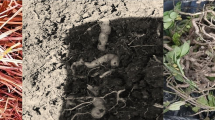Abstract
The wound infection is one of the frequent complications in patients undergoing surgical operations. Staphylococcus aureus is the most common cause of surgical wounds. Artemisia absinthium has been shown to bear strong antimicrobial activity, especially against Gram-positive pathogens. This study was designed to investigate the antimicrobial effects of A. absinthium against surgical wounds infected by S. aureus in a rat model. Twenty male Sprague–Dawley rats were divided randomly into two equal groups of treated and control rats. A circular incision was created on the dorsal inter-scapular region of each rat. After skin wounding, rats were inoculated locally with 1 × 104 CFU of S. aureus at sites of skin wounds. The extract was applied topically twice a day throughout the experiment. Animals of the control group were left untreated. Results have revealed that topical application of A. absinthium extract on the infected wound sites produced significant antibacterial activity against S. aureus.

Similar content being viewed by others
References
Paocharoen V, Mingmalairak C, Apisarnthanarak A (2009) Comparison of surgical wound infection after preoperative skin preparation with 4 % chlorhexidine and povidone iodine: a prospective randomized trial. J Med Assoc Thail 92:898–902
Nandi PL, Soundara Rajan S, Mak KC, Chan SC, So YP (1999) Surgical wound infection. Hong Kong Med J 5:82–86
Onche I, Adedeji O (2004) Microbiology of post-operative wound infection in implant surgery. Niger J Surg Res 6:37–40
Naik G, Deshpande S (2011) A study on surgical site infections caused by Staphylococcus aureus with a special search for methicillin-resistant isolates. J Clin Diagn Res 5:502–508
Essawi T, Srour M (2000) Screening of some Palestinian medicinal plants for antibacterial activity. J Ethnopharmacol 70:343–349
Guangrong H, Jiaxin J, Dehui D (2008) Antioxidative and antibacterial activity of the methanol extract of Artemisia anomala S. Moore. Afr J Biotechnol 7:1335–1338
Hedi M, Hajlaoui H, Akrout A, Najjaa H, Neffati M (2010) Antimicrobial and antioxidant activities of Artemisia herba-alba essential oil cultivated in Tunisian arid zone. C R Chim 13:380–386
Karabegovic I, Nikolova M, Velickovic D, Stojicevic S, Veljkovic V, Lazic M (2011) Comparison of antioxidant and antimicrobial activities of methanolic extracts of the Artemisia sp. recovered by different extraction techniques. Chin J Chem Eng 19:504–519
Fiamegos YC, Kastritis PL, Exarchou V, Han H, Bonvin AM, Vervoort J, Lewis K, Hamblin MR, Tegos GP (2011) Antimicrobial and efflux pump inhibitory activity of caffeoylquinic acids from Artemisia absinthium against Gram-positive pathogenic bacteria. PLoS One 6:1–12
Stratford AF, Zoutman DE, Davidson JSD (2002) Effect of lidocaine and epinephrine on Staphylococcus aureus in a guinea pig model of surgical wound infection. Plast Reconstr Surg 110:1275–1279
Barker W, Rodeheaver GT, Edgerton MT, Edlich RF (1982) Damage to tissue defenses by a topical anesthetic agent. Ann Emerg Med 11:307–310
Coyle MB (2005) Manual of antimicrobial susceptibility testing. American Society for Microbiology, Washington, DC, pp 53–62
Nezhadali A, Parsa M (2010) Study of the volatile compounds in Artemisia absinthium from Iran using HS/SPME/GC/MS. Adv Appl Sci Res 1:174–179
Jeong-Dan C (2007) Chemical composition and antibacterial activity against oral bacteria by the essential oil of Artemisia iwayomogi. J Bacteriol Virol 37:129–136
Moghtader M, Afzali D (2009) Study of the antibacterial properties of the essential oil of Rosemary. Am Eurasian J Agric Environ Sci 5:393–397
Izadi Z, Esna-Ashari M, Piri K, Davoodi P (2010) Chemical composition and antimicrobial activity of feverfew (Tanacetum parthenium) essential oil. Int J Agric Biol 12:759–763
Karuppusamy S, Muthuraja G, Rajasekaran KM (2009) Chemical composition and antimicrobial activity of essential oil from fruits of Vanasushava pedata (Apiaceae). Adv Biol Res 3:196–200
Mishra D, Joshi S, Bisht G, Pilkhwal S (2010) Chemical composition and antimicrobial activity of Solidago Canadensis Linn. Root essential oil. J B Clin Pharm 1:187–190
Essien E, Aboaba S, Ogunwande I (2011) Constituents and antimicrobial properties of the leaf essential oil of Gossypium barbadense (Linn.). J Med Plants Res 5:702–705
Hammami I, Triki MA, Rebai A (2011) Chemical compositions, antibacterial and antioxidant activities of essential oil and various extracts of Geranium sanguineum L. flowers. Arch Appl Sci Res 3:135–144
Magiatis P, Melliou E, Skaltsounis A, Chinou I, Mitaku S (1999) Chemical composition and antimicrobial activity of the essential oils of Pistacia lentiscus var. chia. Plant Med 65:749–752
Dorman H, Deans S (2000) Antimicrobial agents from plants: antibacterial activity of plant volatile oils. J Appl Microbiol 88:308–316
Filipowicz N, Kaminski M, Kurlenda J, Asztemborska M (2003) Antibacterial and antifungal activity of juniper berry oil and its selected components. Phytother Res 17:227–231
Leite AM, Lima EO, de Souza EL, Diniz MF, Trajano VN, de Medeiros IA (2007) Inhibitory effect of β-pinene, α-pinene and eugenol on the growth of potential infectious endocarditis causing Gram-positive bacteria. Rev Bras Cienc Farm 43:121–126
Helander I, Alakomi H, Latva-kala K, Mattila-sandholm T, Pol I, Smid E, Gorris L, Wright A (1998) Characterization of the action of selected essential oil components on Gram-negative bacteria. J Agric Food Chem 46:3590–3595
Sikkema J, Debont J, Poolman B (1995) Mechanisms of membrane toxicity of hydrocarbons. Microbiol Rev 59:201–222
Sikkema J, Debont J, Poolman B (1994) Interactions of cyclic hydrocarbons with biological membranes. J Biol Chem 269:8022–8028
Sikkema J, Poolman B, Konings W, Debont J (1992) Effects of the membrane action of tetralin on the functional and structural properties of artificial and bacterial membranes. J Bacteriol 174:2986–2992
Weis N, Weigand H, Knobloch K (1985) On the enfluence of terpene and phenylpropane derivatives on bacterial respiration and oxidative phosphorylation. Biol Chem 366:866
Knobloch K, Weis N, Weigand H (1986) Metabolism of antimicrobial activity of essential oils. Plant Med 52:556
Acknowledgments
The authors are grateful to Dr. A. Koochakzadeh, Mr K. Khosravi, Mr M. Yazdani and A. Keshmiri for excellent technica assistance.
Author information
Authors and Affiliations
Corresponding author
Rights and permissions
About this article
Cite this article
Moslemi, H.R., Hoseinzadeh, H., Badouei, M.A. et al. Antimicrobial Activity of Artemisia absinthium Against Surgical Wounds Infected by Staphylococcus aureus in a Rat Model. Indian J Microbiol 52, 601–604 (2012). https://doi.org/10.1007/s12088-012-0283-x
Received:
Accepted:
Published:
Issue Date:
DOI: https://doi.org/10.1007/s12088-012-0283-x




